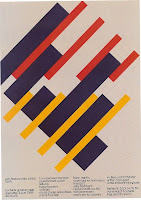Joseph Muller-Brockmann 1914-1996
2.)
Joseph Muller-Brockmann was a Swiss illustrator and designer in the mid 20th Century. His name would become nearly synonymous with Swiss Design, part of the International Typographic Style. His concepts, derived from Modernism, set the rules for the Swiss style of design. Living and working in a cosmopolitan Switzerland gave him the opportunities and influence from a multinational base. He was well-traveled, spent time in the United States and was well-acquainted with many top world designers including Paul Rand.

3.) [No Image]
He was very accomplished and well recognized. In Switzerland he became a member of an underground alliance of modern artists and designers in 1937. In 1951 he became a member of the International Graphic Alliance. He taught at the Zurich School of Art from ‘57-’60, worked as a design consultant for IBM from ‘67-’88, founded and operated an advertising agency, and published books on the history of design, as well as, on his own design concepts. He won the Brunel Award for design excellence three times, in ‘85, ‘87, and ‘94. He won the Gold Medal of the Canton of Zurich in ‘87, was nominated by the Royal Academy of London as an Honorable Royal Designer, and won the Middleton Award for art and design in 1990 in Chicago.
4.) [No Image]
Muller-Brockmann was born in 1914 in Rapperswil, Switzerland near Zurich. In his early career, he began studying graphic design in his late teens as an apprentice and later at the Zurich School of Art. His immediate inspiration came from his teachers, designers Ernest Keller and Alfred Willimann, and photographer Hans Finsler, as well as, other emerging modernist Swiss designers. Muller-Brockmann built a large variety of skills from a lot of influence and had many directions to choose from. He worked as a free-lance designer and illustrator in the mid-‘30s.
5.) [No Image]
This was during World War II and Muller-Brockmann served some time as a lieutenant in the Swiss Army from the late ‘30s to early ‘40s. Switzerland remained politically neutral during the conflict but remained ideally traditional and followed neo-classical style, much like the Nazi regime in Germany. Nazi standards for art were classical with motifs of victory and prestige. Expressive and modern art was frowned upon and prosecuted. Small groups of graphic designers exiled from Germany moved to Switzerland and began a small modernist movement.
6.) [No Image]
Photography was a swiftly advancing technology and was advancing in the design field. Its precision influenced younger designers to explore the artistic value of such precision and constructive form.
7.)
After the war, Swiss style began to move away from the neo-classical style to a modern geometric style. It was an attempt to move away from traditional styles that now became associated with fascism. One of the biggest style changes in design was typeface. The Typographic Style rejected fonts associated with neo-classicism, such as Times Roman and opted for a font separate from any negative political prejudices. This font was called Akzidenz-Grotesk, a sans-serif font, similar to Arial and Helvetica, created in 1896. Akzidenz-Grotesk was simple, geometric, and void of any bias.
8.)
In the late ‘40s, Muller-Brockmann resumed illustrating and advertisement design. His drawing style was expressive, surreal, and even cartoonish. Some of his advertisements were for Hermes typewriters. In 1945, an early ad shows a very detailed drawing of a scene with cartoon figures in different window settings at work with their typewriters. Again, this is much more illustrated than designed.
These ads from ‘49-’51 show more showcasing of the product with colorful drawings and designs.




















































